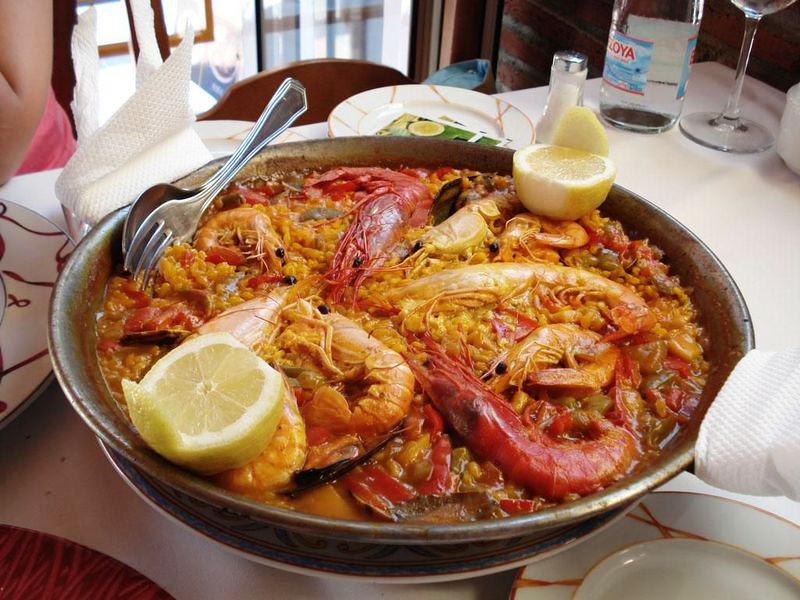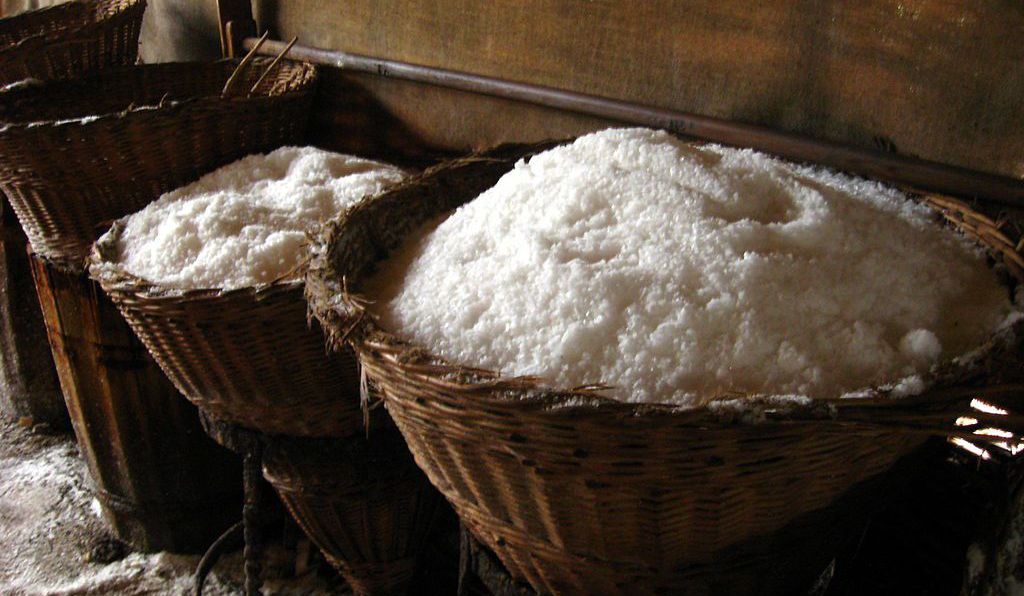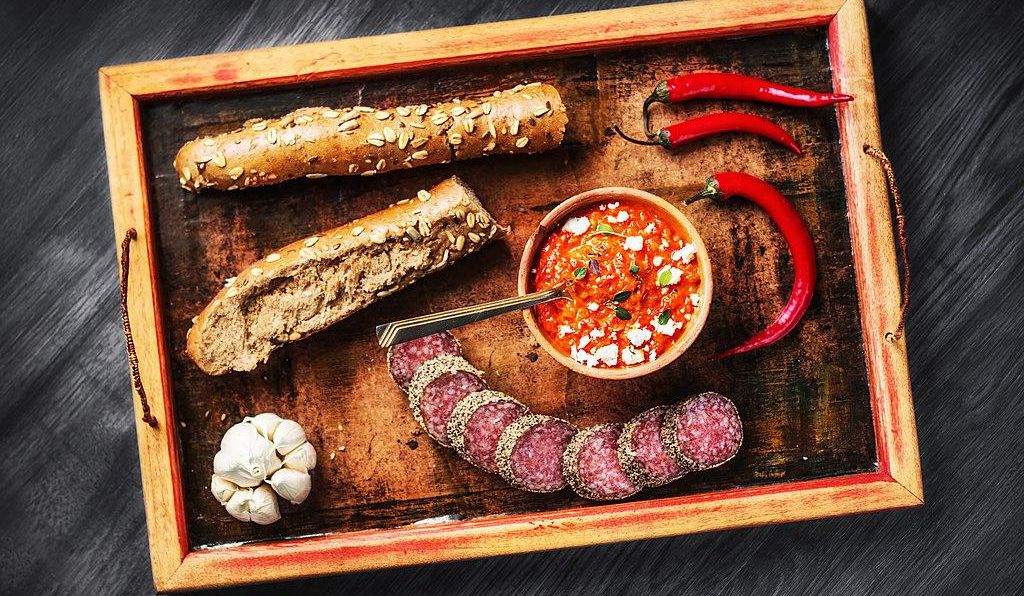A new Smithsonian book whisks readers on a culinary odyssey, tracing the history of salt, pork, honey, chili, tomato, rice and chocolate

At first blush, pork, honey, salt, chile, rice, chocolate and tomato may seem an unremarkable and arbitrary grocery list. Consumers everywhere are well acquainted with pork chops, Honey Nut Cheerios, instant ramen, canned chili, prefab sushi, Hershey’s candy bars and tomato soup. But longtime food writer Jenny Linford sees in these easily overlooked dietary staples the quiet champions of culinary history, worthy of celebration and scholarly examination for their enduring worldwide appeal, surprising versatility and fascinating backstories.
In Linford’s latest, a Smithsonian Books publication titled The Seven Culinary Wonders of the World, the author both gives her readers a taste of the history behind each ingredient and peppers the seven chapters with a selection of scrumptious, easily prepared recipes exhibiting the wide-ranging applicability of the comestibles under consideration.

Number 1: Prodigious Pork
From breakfast bacon to slow-cooked pork shoulder, the meat of the pig has a prodigious range of uses, a range that explains in part pork’s status as the most popular meat on Earth despite the injunctions of two dominant world religions, Judaism and Islam.
Linford traces the history of pig domestication back more than 10,000 years, pointing to a dig site in Turkey dating to around 8000 B.C. and Chinese pig bones of similar vintage. The symbolism behind the pig was always contentious—while the mud-loving animal that could ingest almost anything on Earth and grow fat, juicy and delicious in the process was prized by the Chinese, other sources, including the Torah and Qur’an, were not so charitable. They saw the pig as an emblem of sin and squalor, a tainted creature to be avoided at all costs.
In societies that did embrace the pig, the animal came to define major traditions of cultural life. Mystical boars grace both Celtic and Greek mythology, and the gentlemanly ritual of the truffle hunt persists to this day around Europe. Medieval texts are populated with descriptions of the customary December pig slaughter, and farmers all over the world perpetuate these practices into the present.
Linford’s hearty recipes in this section encompass an impressive array of cultures, and run the gamut from Chinese pork potstickers to barbecued ribs to sautéed chorizo with red wine.

Number 2. Golden Honey
The second ingredient in Linford’s standout septet is honey, an emblem of sweetness and prosperity with just as deep a history as pork. The Spider Caves in Valencia, Spain, bear a painted depiction of honey harvesting dating back six to eight millennia, and the ancient Egyptians were ardent beekeepers who consigned honey to their tombs for sweet rewards in the afterlife.
Linford notes that the art of apiculture steadily spread across continents, reaching the Levant by 1500 B.C. and prompting a major Chinese beekeeping treatise in the sixth century B.C. Honey journeyed across the Atlantic in the early 1600s A.D., conveyed to Central and South America by voyagers from Spain. By the mid-19th century, North American apiarist Lorenzo Langstroth had pioneered an easily accessible top-opening hive structure that greatly simplified the handling of honeybees, and that paved the way for a booming beekeeping business in the years to come.
Linford observes that honey has long been a metaphor for the pleasing and joyous. Moses’ biblical Promised Land is described as the “land of milk and honey,” and the flattering adjective “mellifluous” derives from the Latin for “honey.” Modern-day conservationists are capitalizing on the cultural cachet of the honeybee to stress the importance of all pollinators, without which the natural world would lose much of its richness.
Honey-sweetened treats highlighted in the book include honey-glazed chicken, honey ice cream and the classic winter beverage known as the hot toddy.

Number 3. Sacred Salt
Salt is a culinary staple so essential that we tend not to give it a second thought. Saltiness is one of the five basic tastes perceptible by the human palate (the others are sweet, sour, bitter and umami), and the crystalline ionic compound is omnipresent on tables in lavish restaurants, private homes and everywhere in between.
Like honey, salt saw some of its earliest use in ancient Egyptian society, where it was prized as a preservative in the mummification process. The remarkable desiccant known as natron was called “the divine salt” in Egyptian culture, and was employed to sap the moisture from the bodies of those en route to the afterlife. Transoceanic sailors of later millennia would rely on the same preservative properties to keep meat and other foodstuffs from rot on their voyages.
The reach of salt’s history back into classical times can be explained in part by the highly intuitive way in which it is harvested: let the sun evaporate puddles of sea water and you’ll be left with readily accessible salt deposits. Variations on this evaporation technique, which Pliny the Elder wrote about in the first century A.D., are still in use to this day. Pliny also described the much more perilous enterprise of salt excavation in labyrinthine cavern complexes, which Linford notes has been immortalized in the workingman’s idiom “Back to the salt mines.”
These days, salt is enjoying a culinary heyday, as artisanal patisseries battle to one-up each other in their creative use of sea salt and other prized varieties. Linford’s salty recipes include salt cod croquettes, salted rosemary focaccia and salted caramel sauce suitable for an ice cream sundae.

Number 4. Tongue-Searing Chili
Nothing says spicy like good old-fashioned chili peppers, the mention of which tends either to inspire gung-ho gamesmanship among diners or send them running for the hills. Linford writes that the first chilis were likely endemic to Bolivia, but they quickly proliferated across South America, Mesoamerica, and the Caribbean. Upon his 1492 arrival in Hispaniola, Christopher Columbus was presented with chilis grown by indigenous islanders, which he passed along to King Ferdinand and Queen Isabella upon his return to Spain. The tongue-searing spiciness of the peppers was a novelty to the Spanish court, and chili fever was soon in full swing.
Spanish missionaries and conquistadors brought home with them further knowledge of the chili, which played a central role in Incan and Aztec culture. Linford notes that the word “chili” itself entered European language from the Aztec language Nahuatl, in which “chil” denoted both the chili pepper and the color red. Knowledge of these piquant peppers and how to grow them was carried far and wide by Portuguese and Spanish sailors. It was Vasco de Gama, for instance, who brought chilis to India, where they gave rise to the panoply of spicy curries that predominate in Indian cuisine to this day.
Well known for its association with the brutally spicy soups and rice dishes of Thailand and Sichuan China, as well as with the fieriest offerings of Latin American and Italian fare, the chili has accrued a kind of notoriety over the years, and masochistic diners relish the opportunity to put their taste buds to the test. Linford notes that spicier and spicier chilis are specially cultivated every year, and that there is a niche competitive market for them. In 2016, an American man scarfed down 22 of the world’s spiciest peppers, Carolina Reapers, each one an order of magnitude hotter than the hottest of habaneros.
The recipes Linford offers in this chapter pack a much more manageable punch, though if you’re not a fan of spicy foods it’s still probably best to steer clear. Featured dishes include Jamaican jerk chicken, Chinese crispy chili beef and Italian spaghetti with chili peppers.

Number 5. Water-Loving Rice
It’s impossible to conceive of Asian cuisine without rice, and understandably so: Linford writes that archaeological evidence suggests rice was being cultivated along China’s Yangtze River as many as 10,000 years ago. China and India were the earliest hotbeds of rice agriculture, but their expertise soon found its way to Japan, Korea, Southeast Asia, and the Middle East, whence Arabian peoples brought knowledge of rice to Spain, a place where it now also thrives (as the base of the proud national dish paella, among so many others).
Rice crops rapidly wither and die when dehydrated, a phenomenon that has long favored the use of deliberately flooded paddies for rice agriculture. Much of the elaborately terraced paddy acreage in Asia is marvelous to behold, and Linford notes that the Philippines’ mountainside terrace system is considered among some to be the “eighth wonder of the world.”
Linford explains that rice is such an integral part of daily life in Asia that all manner of folklore and ceremony has coalesced around the crop over hundreds of years. Rice cakes are propitious treats at festivals ringing in the Chinese lunar New Year, and in certain cultures leaving even a single grain uneaten in one’s bowl is seen as a karmic no-no. The development of thousands of resilient rice cultivars has seen the staple spread far beyond Asia, of course, ushering it into American Cajun cuisine, for instance, or Italian in the form of fluffy risotto.
Linford’s selection of rice recipes understandably focuses on Asian food, and includes ideas for cucumber sushi rolls, egg-fried rice and the Korean classic bibimbap. Those seeking alternative spins on the cereal can check out her preparations for vanilla rice pudding and Jamaican “rice ’n’ peas.”

Number 6. Sumptuous Cacao
The cacao plant, mother of all chocolate products, is widely beloved, and has been for some time. Linford writes that its scientific name, Theobroma cacao, translates to “food of the gods,” and its enjoyment can be traced back to the Olmec, Maya and Aztec peoples of ancient Mesoamerica. Among the Maya and Aztec, cacao-derived beverages were imbibed by the elites of society, and the beans were revered to the point that they were both used as currency and held to possess magical powers.
Once again, it was the rapacious incursions of the conquistadors that were responsible for bringing the traditional culinary practice of native Mesoamericans into the global consciousness. Like “chili,” “chocolate” is a Nahuatl-derived word, and as with chilis, cacao was popularized in Europe by Spaniards returning from expeditions to the New World. Drinking chocolate became the pinnacle of sumptuous luxury in many circles, and in 1662 Pope Alexander VII made it clear that doing so was permissible even on fast days (“Liquids do not break the fast.”)
Linford writes that in the mid-1800s, a British Quaker chocolate manufacturing outfit called J.S. Fry & Son lit on the revolutionary technique of “mixing together cocoa powder, sugar and cacao butter to create a paste that could be molded into bars,” giving rise to the first-ever chocolate bars. American Milton Hershey seized on this idea and ran with it, turning chocolate into a big, industrial business and churning out Hershey bars from 1900 onward.
Chocolate now pervades markets in countries all around the globe, whether in the form of artisanal confections, mundane movie theater snacks or rich entrees like Mexican mole dishes. Included among Linford’s suggested recipes are ideas for rum chocolate truffles, chocolate cake, luxurious hot chocolate and triple chocolate cookies.

Number 7. The Humble Tomato
Hammering home the theme of Spanish conquest as a vehicle for the introduction of New World foods to Europe is the example of the humble tomato, which many today associate primarily with the cuisine of Italy and yet which, like the chili pepper and cacao plant, has its origins in South and Central America. Linford calls attention to the 1554 writings of Italian doctor and botanist Pietro Andrea Mattioli, which heralded the arrival of tomatoes on the European continent and dubbed them “golden apples”—pomi d’oro in Italian (hence “pasta al pomodoro”).
This glamorous nickname linked tomatoes to the golden apples found in Greek myth, and lent them a mysterious and otherworldly quality alluring to many of the day’s botanists and chefs. At the same time, the tomato plant’s status as a member of the nightshade family meant that it was regarded with deep skepticism by others. Love it or loathe it, everyone had an opinion on the glistening fruits of the New World, whose controversy set the stage for their rapid distribution worldwide.
Tomatoes need unremitting sunshine in order to grow, which made the Mediterranean clemency of Italy the ideal choice for those looking to cultivate them. The Italian culinary essentials of tomato-based pizza sauce and marinara pasta sauce blossomed out of the region’s increasing obsession with the plant. Meanwhile, in North America, even Thomas Jefferson got in on the craze, growing tomatoes on his sprawling Monticello estate from 1809 to 1820.
Nowadays, tomatoes rank among the most widely cultivated vegetables (or fruits, depending on your definition—Linford wades into this debate in the book), with 88 million tons of fresh tomatoes and 42 million of tomatoes in processed form hitting markets annually. Tomatoes are vital to every bottle of ketchup and every fast food helping of pico de gallo, and appear in countless salads and sandwiches. They are as close to universal as a foodstuff can get, and make for a fitting conclusion to Linford’s globetrotting culinary survey.
As for her personal tomato-based favorites, Linford recommends recipes for tomato crostini, fried green tomatoes, heirloom tomato salad and the Spanish standby gazpacho.